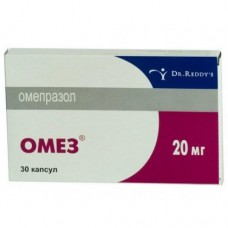Expiration date: 01/2026
Capsules. 1 capsule contains:
omeprazole 10, 20 or 40 mg
excipients: mannitol sodium lactose sodium lauryl sulfate hydrophosphate sucrose sucrose (25/30) hypromellose (6 cps)
capsule shell: hypromellose (6 cps)
intestinal-soluble membrane: methacrylic acid copolymer (type C) — methacrylic acid and methyl methacrylate sodium hydroxide macrogol 6000 talc titanium dioxide
Description of the dosage form:
Solid transparent gelatin capsules of size 2 with a colorless body and a pink cap with the inscription "OMEZ" on both parts of the capsule, filled with white or almost white granules.
Pharmacokinetics:
Omeprazole is rapidly absorbed from the gastrointestinal tract, Cmax in plasma is reached after 0, 5-1 hours.Bioavailability is 30-40%. Binding to plasma proteins is about 90%. Omeprazole is almost completely metabolized in the liver. T1/2 — 0, 5-1 h. It is mainly excreted by the kidneys as metabolites. In chronic renal failure, excretion decreases in proportion to the decrease in Creatinine CL. In elderly patients, excretion decreases and bioavailability increases. In hepatic insufficiency, bioavailability is 100%, T1/2 — 3 hours.
Description of pharmacological action:
Omeprazole inhibits the enzyme H+- K+- ATPase ("proton pump") in the parietal cells of the stomach and thus blocks the final stage of hydrochloric acid synthesis. This leads to a decrease in basal and stimulated secretion, regardless of the nature of the stimulus. After a single oral administration of the drug, the effect of omeprazole occurs within the first hour and lasts for 24 hours, the maximum effect is achieved after 2 hours. In patients with duodenal ulcer, 20 mg of omeprazole maintains an intragastric pH of 3, 0 for 17 hours. After discontinuation of the drug, secretory activity is fully restored in 3-5 days.
Indications:
- peptic ulcer of the stomach and duodenum
- reflux esophagitis
- erosive and ulcerative lesions of the stomach and duodenum associated with NSAIDs, stress ulcers
- erosive and ulcerative lesions of the stomach and duodenum associated with Helicobacter pylori (as part of complex therapy)
- Zollinger-Ellison syndrome.
Contraindications:
- hypersensitivity to the drug
- pregnancy
- breast-feeding
- children's age.
Use during pregnancy and lactation:
Contraindicated during pregnancy. Breast-feeding should be stopped during treatment.
Side effect:
In rare cases, the following usually reversible side effects may occur:
From the digestive system — diarrhea or constipation, nausea, vomiting, flatulence, abdominal pain, dry mouth, taste disorders, stomatitis, transient increase in the level of liver enzymes in plasma in patients with previous severe liver disease — hepatitis (including jaundice), liver function disorders.
From the nervous system: headache, dizziness, agitation, drowsiness, insomnia, paresthesia, depression, hallucinations in patients with severe concomitant somatic diseases, patients with previous severe liver disease — encephalopathy.
From the musculoskeletal system: muscle weakness, myalgia, arthralgia.
From the hematopoietic system: leukopenia, thrombocytopenia in some cases — agranulocytosis, pancytopenia.
From the skin: itching in some cases — photosensitization, erythema multiforme, alopecia.
Allergic reactions: urticaria, angioedema, bronchospasm, interstitial nephritis and anaphylactic shock.
Other: visual impairment, peripheral edema, increased sweating, fever, gynecomastia rarely — the formation of gastric glandular cysts during long-term treatment (a consequence of inhibition of hydrochloric acid secretion, is benign, reversible).
Drug interaction:
Long-term use of omeprazole at a dose of 20 mg once a day in combination with caffeine, theophylline, piroxicam, diclofenac, naproxen, metoprolol, propranolol, ethanol, cyclosporine, lidocaine, quinidine and estradiol did not lead to changes in their plasma concentrations. There was no interaction with simultaneously taken antacids. Changes the bioavailability of any drug whose absorption depends on the pH value (for example, iron salts).
Dosage and administration:
Inside, with a small amount of water (the contents of the capsule can not be chewed), 30 minutes before meals.
In case of exacerbation of peptic ulcer disease, reflux esophagitis and NSAIDs-gastropathy-20 mg 2 times a day. The course of treatment for duodenal ulcer is 2-3 weeks, if necessary — 4-5 weeks for gastric ulcer and reflux esophagitis — 4-8 weeks.
With Zollinger-Ellison syndrome — 60 mg, if necessary, the dose is increased to 80-120 mg/day (in this case, it is prescribed in 2-3 doses).
Prevention of Mendelssohn syndrome — 40 mg 1 hour before surgery (if the operation is longer than 2 hours, the necessary dose of the drug should be re-administered).
To prevent the development of NSAIDs-gastropathy and relapses of peptic ulcer disease — 20 mg once a day.
For eradication of Helicobacter pylori, "triple" therapy is used (for 7-14 days: omeprazole 20 mg, amoxicillin 1, 0 g, clarithromycin 500 mg — 2 times a day or omeprazole 20 mg, clarithromycin 250 mg, metronidazole 400 mg — 2 times a day).
In case of hepatic insufficiency, the daily dose is not more than 20 mg.
If renal function is impaired and elderly patients do not need to adjust the dosage regimen.
Overdose:
Symptoms: visual impairment, drowsiness, agitation, confusion, headache, increased sweating, dry mouth, nausea, arrhythmia.
Treatment: symptomatic. Hemodialysis is not effective enough.
There is no specific antidote.
Special instructions:
Before starting therapy, it is necessary to exclude the presence of a malignant process (especially with stomach ulcers), because treatment, masking the symptoms, can delay the correct diagnosis.
Taking the drug simultaneously with food does not affect its effectiveness.
In patients with severe hepatic insufficiency, the daily dose should not exceed 20 mg.




